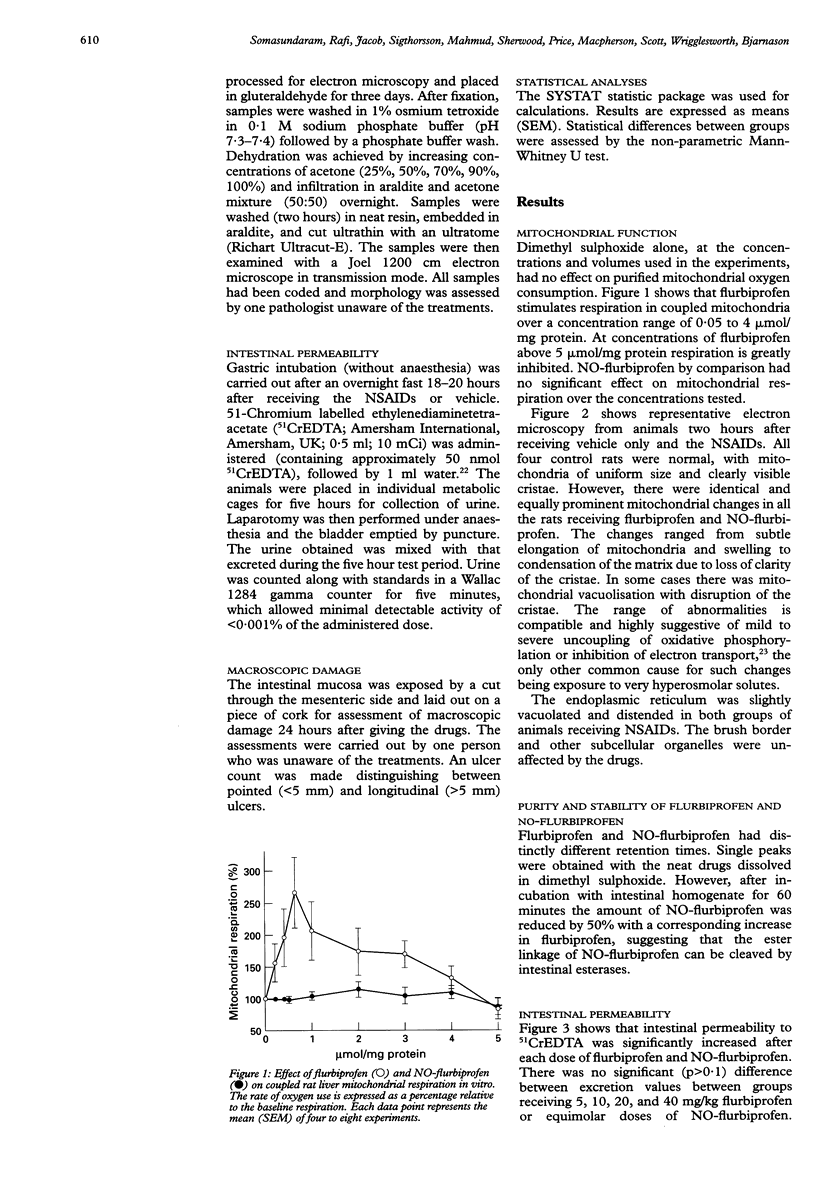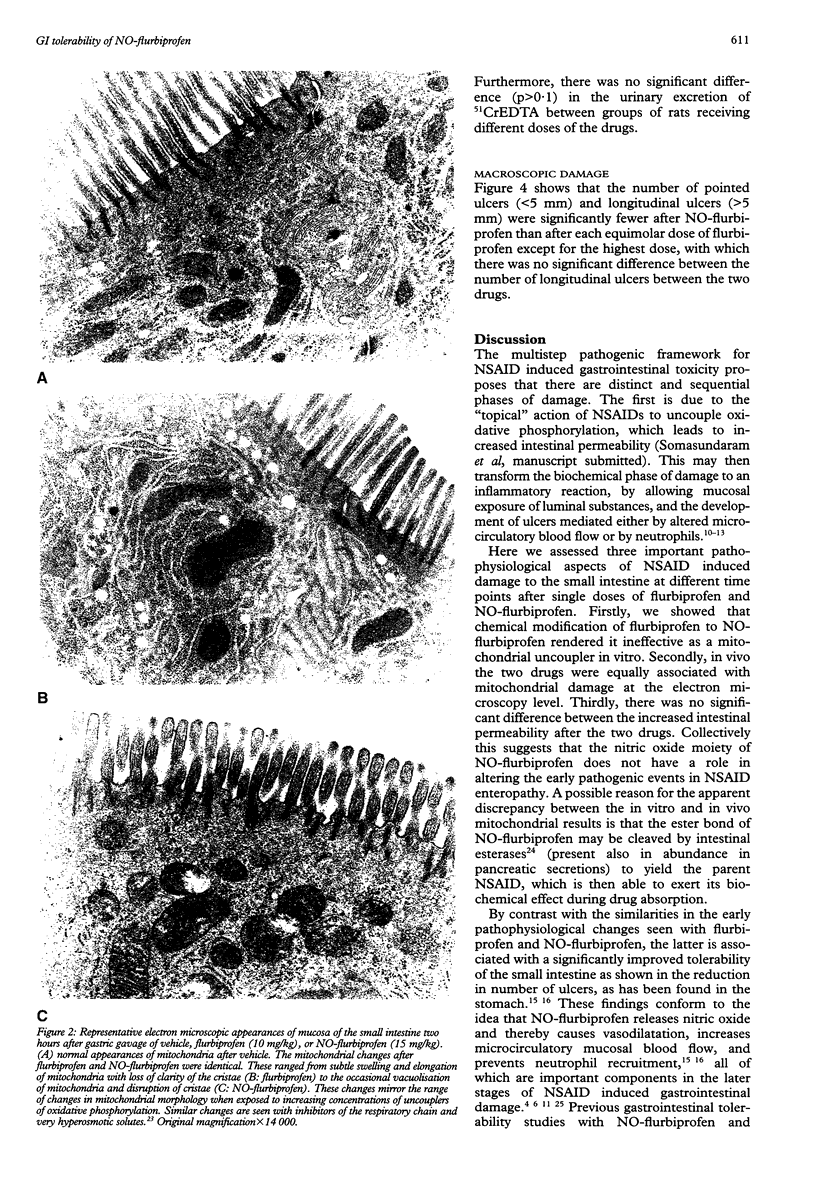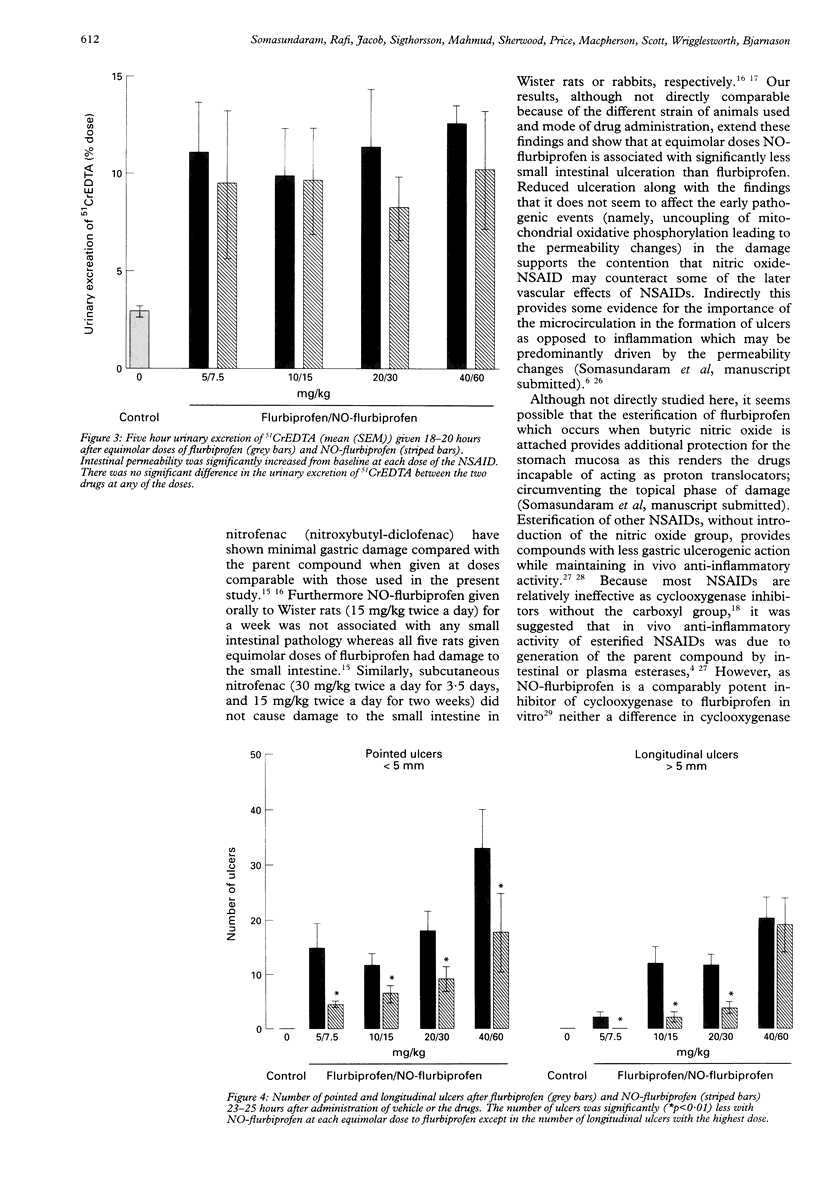Abstract
BACKGROUND: Nitric oxide derivatives of non-steroidal anti-inflammatory drugs (NSAIDs) are thought to be much less ulcerogenic than their parent compounds. AIM: To compare the effect and potency of flurbiprofen and nitroxybutyl-flurbiprofen to uncouple mitochondrial oxidative phosphorylation (an early pathogenic event in NSAID enteropathy), increase intestinal permeability (transitional stage), and cause macroscopic small intestinal damage. METHODS: In vitro uncoupling potency was assessed using isolated coupled rat liver mitochondria and in vivo by electron microscopy of rat small intestinal mucosa (two hours after the drugs). A dose-response study with flurbiprofen (single doses of 5, 10, 20, and 40 mg/kg) and equimolar doses of nitroxybutyl-flurbiprofen was performed; assessing their effect on intestinal permeability (at 18-20 hours), with 51Cr EDTA, and the number of pointed (< 5 mm) and longitudinal (> 5 mm) small intestinal ulcers at 24 hours. RESULTS: Flurbiprofen, but not nitroxybutyl-flurbiprofen, stimulated coupled respiration in vitro. Both drugs, however, uncoupled in vivo; in the case of nitroxybutyl-flurbiprofen possibly because hydrolysis of its ester bond released free flurbiprofen. Intestinal permeability was uniformly and equally increased with both drugs compared with controls. The number of small intestinal ulcers, pointed and longitudinal, was significantly reduced with nitroxybutyl-flurbiprofen apart from the number of longitudinal ulcers with the highest dose. CONCLUSIONS: These studies show that nitroxybutyl-flurbiprofen is associated with significantly less macroscopic damage in the small intestine than flurbiprofen but was associated with mitochondrial damage in vivo and caused similar increases in permeability of the small intestine, suggesting that its beneficial effect is on the later pathogenic stages of the damage.
Full text
PDF





Images in this article
Selected References
These references are in PubMed. This may not be the complete list of references from this article.
- Armstrong C. P., Blower A. L. Non-steroidal anti-inflammatory drugs and life threatening complications of peptic ulceration. Gut. 1987 May;28(5):527–532. doi: 10.1136/gut.28.5.527. [DOI] [PMC free article] [PubMed] [Google Scholar]
- Barrier C. H., Hirschowitz B. I. Controversies in the detection and management of nonsteroidal antiinflammatory drug-induced side effects of the upper gastrointestinal tract. Arthritis Rheum. 1989 Jul;32(7):926–932. [PubMed] [Google Scholar]
- Bjarnason I., Fehilly B., Smethurst P., Menzies I. S., Levi A. J. Importance of local versus systemic effects of non-steroidal anti-inflammatory drugs in increasing small intestinal permeability in man. Gut. 1991 Mar;32(3):275–277. doi: 10.1136/gut.32.3.275. [DOI] [PMC free article] [PubMed] [Google Scholar]
- Bjarnason I., Smethurst P., Levi A. J., Peters T. J. Intestinal permeability to 51Cr-EDTA in rats with experimentally induced enteropathy. Gut. 1985 Jun;26(6):579–585. doi: 10.1136/gut.26.6.579. [DOI] [PMC free article] [PubMed] [Google Scholar]
- CHANCE B., WILLIAMS G. R. The respiratory chain and oxidative phosphorylation. Adv Enzymol Relat Subj Biochem. 1956;17:65–134. doi: 10.1002/9780470122624.ch2. [DOI] [PubMed] [Google Scholar]
- Elliott S. N., McKnight W., Cirino G., Wallace J. L. A nitric oxide-releasing nonsteroidal anti-inflammatory drug accelerates gastric ulcer healing in rats. Gastroenterology. 1995 Aug;109(2):524–530. doi: 10.1016/0016-5085(95)90341-0. [DOI] [PubMed] [Google Scholar]
- Fuhro R., Fromm D. Effects of compounds chemically related to salicylate on isolated antral mucosa of rabbits. Gastroenterology. 1978 Oct;75(4):661–667. [PubMed] [Google Scholar]
- Hawkey C. J. Future treatments for arthritis: new NSAIDs, NO NSAIDs, or no NSAIDs? Gastroenterology. 1995 Aug;109(2):614–616. doi: 10.1016/0016-5085(95)90353-4. [DOI] [PubMed] [Google Scholar]
- Langenbach R., Morham S. G., Tiano H. F., Loftin C. D., Ghanayem B. I., Chulada P. C., Mahler J. F., Lee C. A., Goulding E. H., Kluckman K. D. Prostaglandin synthase 1 gene disruption in mice reduces arachidonic acid-induced inflammation and indomethacin-induced gastric ulceration. Cell. 1995 Nov 3;83(3):483–492. doi: 10.1016/0092-8674(95)90126-4. [DOI] [PubMed] [Google Scholar]
- Mathias P. M., Harries J. T., Peters T. J., Muller D. P. Studies on the in vivo absorption of micellar solutions of tocopherol and tocopheryl acetate in the rat: demonstration and partial characterization of a mucosal esterase localized to the endoplasmic reticulum of the enterocyte. J Lipid Res. 1981 Jul;22(5):829–837. [PubMed] [Google Scholar]
- Picot D., Loll P. J., Garavito R. M. The X-ray crystal structure of the membrane protein prostaglandin H2 synthase-1. Nature. 1994 Jan 20;367(6460):243–249. doi: 10.1038/367243a0. [DOI] [PubMed] [Google Scholar]
- Rainsford K. D., Whitehouse M. W. Anti-inflammatory/anti-pyretic salicylic acid esters with low gastric ulcerogenic activity. Agents Actions. 1980 Nov;10(5):451–456. doi: 10.1007/BF01968046. [DOI] [PubMed] [Google Scholar]
- Somasundaram S., Hayllar H., Rafi S., Wrigglesworth J. M., Macpherson A. J., Bjarnason I. The biochemical basis of non-steroidal anti-inflammatory drug-induced damage to the gastrointestinal tract: a review and a hypothesis. Scand J Gastroenterol. 1995 Apr;30(4):289–299. doi: 10.3109/00365529509093280. [DOI] [PubMed] [Google Scholar]
- Umeki S. Activation factors of neutrophil NADPH oxidase complex. Life Sci. 1994;55(1):1–13. doi: 10.1016/0024-3205(94)90076-0. [DOI] [PubMed] [Google Scholar]
- WHITEHOUSE M. W. BIOCHEMICAL PROPERTIES OF ANTI-INFLAMMATORY DRUGS--III. UNCOUPLING OF OXIDATIVE PHOSPHORYLATION IN A CONNECTIVE TISSUE (CARTILAGE) AND LIVER MITOCHONDRIA BY SALICYLATE ANALOGUES: RELATIONSHIP OF STRUCTURE TO ACTIVITY. Biochem Pharmacol. 1964 Mar;13:319–336. doi: 10.1016/0006-2952(64)90148-0. [DOI] [PubMed] [Google Scholar]
- Wallace J. L., Arfors K. E., McKnight G. W. A monoclonal antibody against the CD18 leukocyte adhesion molecule prevents indomethacin-induced gastric damage in the rabbit. Gastroenterology. 1991 Apr;100(4):878–883. doi: 10.1016/0016-5085(91)90259-n. [DOI] [PubMed] [Google Scholar]
- Wallace J. L., Granger D. N. Pathogenesis of NSAID gastropathy: are neutrophils the culprits? Trends Pharmacol Sci. 1992 Apr;13(4):129–131. doi: 10.1016/0165-6147(92)90046-9. [DOI] [PubMed] [Google Scholar]
- Wallace J. L., Keenan C. M., Granger D. N. Gastric ulceration induced by nonsteroidal anti-inflammatory drugs is a neutrophil-dependent process. Am J Physiol. 1990 Sep;259(3 Pt 1):G462–G467. doi: 10.1152/ajpgi.1990.259.3.G462. [DOI] [PubMed] [Google Scholar]
- Wallace J. L., Reuter B., Cicala C., McKnight W., Grisham M. B., Cirino G. Novel nonsteroidal anti-inflammatory drug derivatives with markedly reduced ulcerogenic properties in the rat. Gastroenterology. 1994 Jul;107(1):173–179. doi: 10.1016/0016-5085(94)90074-4. [DOI] [PubMed] [Google Scholar]
- Wallace J. L., Reuter B., Cicala C., McKnight W., Grisham M., Cirino G. A diclofenac derivative without ulcerogenic properties. Eur J Pharmacol. 1994 May 23;257(3):249–255. doi: 10.1016/0014-2999(94)90136-8. [DOI] [PubMed] [Google Scholar]
- Wallace J. L. The 1994 Merck Frosst Award. Mechanisms of nonsteroidal anti-inflammatory drug (NSAID) induced gastrointestinal damage--potential for development of gastrointestinal tract safe NSAIDs. Can J Physiol Pharmacol. 1994 Dec;72(12):1493–1498. doi: 10.1139/y94-215. [DOI] [PubMed] [Google Scholar]
- Weiss S. J. Tissue destruction by neutrophils. N Engl J Med. 1989 Feb 9;320(6):365–376. doi: 10.1056/NEJM198902093200606. [DOI] [PubMed] [Google Scholar]



